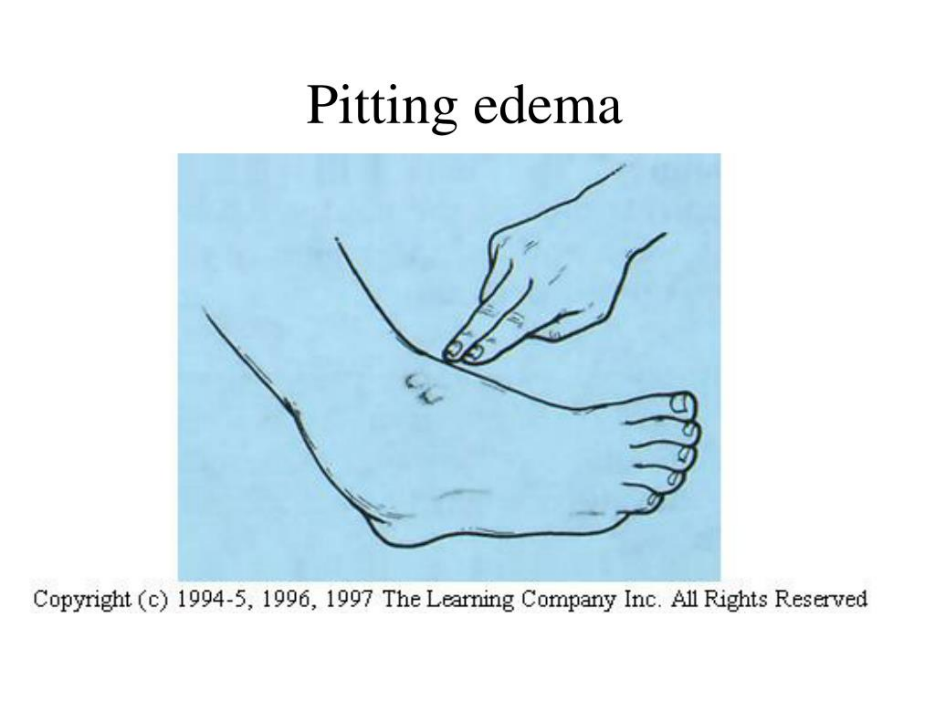In which disease process should a nurse expect to see a patient with the presence of pitting edema?
Diabetes mellitus
Liver disease
End-stage renal disease
Colon cancer
The Correct Answer is B
Choice A reason:
Diabetes mellitus is not typically associated with pitting edema unless it has led to a comorbid condition such as heart failure or kidney disease. Pitting edema is more commonly associated with fluid retention due to the body's inability to manage fluid balance, which is not a direct consequence of diabetes mellitus itself.
Choice B reason:
Liver disease, particularly cirrhosis, can lead to pitting edema. The liver's inability to produce albumin, a protein that helps maintain oncotic pressure in the blood vessels, and portal hypertension, which is an increase in the blood pressure within the portal vein system, can both contribute to the development of pitting edema.
Choice C reason:
End-stage renal disease can also cause pitting edema due to the kidneys' inability to excrete excess fluid. However, the edema associated with renal disease is often more generalized and not limited to the lower extremities.
Choice D reason:
Colon cancer is not typically associated with pitting edema unless it has metastasized and caused secondary complications that affect the liver or the heart. Pitting edema is not a direct symptom of colon cancer itself. 
Nursing Test Bank
Naxlex Comprehensive Predictor Exams
Related Questions
Correct Answer is C
Explanation
Choice A Reason:
Family History is used to document health events in the patient's family, including diseases that may be hereditary or place the patient at risk. The statement about feeling like an elephant is sitting on the chest is not related to family health but is a description of the patient's current symptoms.
Choice B Reason:
Past Medical History includes information about the patient's past health issues, surgeries, hospitalizations, allergies, and treatments. It does not include current symptoms or the reasons for the current hospital visit.
Choice C Reason:
The Chief Complaint is the section where the nurse documents the primary reason for the patient's visit in their own words. The phrase "feels like an elephant is sitting on his chest" is a classic description of chest pain or discomfort, often associated with cardiac issues, and would be documented here as it represents the patient's main concern.
Choice D Reason:
Present Illness or History of Present Illness would include a detailed account of the development of the patient's illness or health concern. While it is closely related to the Chief Complaint, it is more detailed and includes the onset, duration, and character of the symptoms, among other aspects. The initial statement would be part of the Chief Complaint, which leads into the more detailed History of Present Illness.
Correct Answer is ["A","B","C","D"]
Explanation
Choice a reason:
Wearing nonslip shoes in the house can prevent falls, which are a common cause of traumatic brain injuries (TBIs) in adolescents. Falls often occur due to slippery surfaces, and nonslip shoes provide better traction, reducing the risk of such accidents.
Choice b reason:
Supervised use of guns by an adult is crucial to prevent accidental shootings, which can result in TBIs or even more severe outcomes. Adolescents may not fully understand the risks associated with handling firearms, and adult supervision ensures that safety measures are followed.
Choice c reason:
The consistent use of seat belts in vehicles is one of the most effective ways to prevent TBIs during car accidents. Seat belts keep occupants from being ejected or hitting the interior of the car, significantly reducing the risk of head injuries.
Choice d reason:
Avoiding risky activities such as snowboarding without proper safety measures can prevent sports-related TBIs. While snowboarding, wearing a helmet and other protective gear is essential to protect the head during falls or collisions.
Whether you are a student looking to ace your exams or a practicing nurse seeking to enhance your expertise , our nursing education contents will empower you with the confidence and competence to make a difference in the lives of patients and become a respected leader in the healthcare field.
Visit Naxlex, invest in your future and unlock endless possibilities with our unparalleled nursing education contents today
Report Wrong Answer on the Current Question
Do you disagree with the answer? If yes, what is your expected answer? Explain.
Kindly be descriptive with the issue you are facing.
